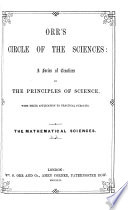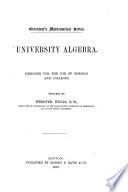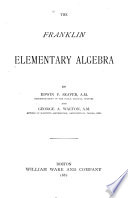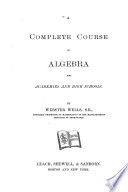 In any proportion the terms are in proportion by. Composition ; that is, the sum of the first two terms is to the first term, as the sum of the last two terms is to the third ter.n. In any proportion the terms are in proportion by. Composition ; that is, the sum of the first two terms is to the first term, as the sum of the last two terms is to the third ter.n.  Complete Secondary Algebra - Page 315by George Egbert Fisher, Isaac Joachim Schwatt - 1901 - 288 pagesFull view Complete Secondary Algebra - Page 315by George Egbert Fisher, Isaac Joachim Schwatt - 1901 - 288 pagesFull view - About this book
 | Thomas Sherwin - Algebra - 1841 - 314 pages
...c; changing the means, b-\-a:b — a = d-\-c:d — c. From the last two proportions, we infer, that, In any proportion, the sum of the first two terms is to the sum of the last two, as the difference of the first two terms is to the difference of the last two... | |
 | William Somerville Orr - Science - 1854 - 534 pages
...in one set, need not be of the same kind as those in the other set. PROPOSITION XVIII.— THEOREM. In any proportion the sum of the first two terms is to their difference as the sum of the other two is to their difference. Let A : В . . С : D ; then A... | |
 | Thomas Sherwin - Algebra - 1855 - 262 pages
...— d. Comparing the last two proportions with the original proportion a : b = c : d, we infer that, In any proportion, the sum of the first two terms is to the sum of the last two, as the difference of the first two terms is to the difference of the last two... | |
 | Thomas Sherwin - 1862 - 252 pages
...— d. Comparing the last two proportions with the original proportion a : b = c : d, we infer that, In any proportion, the sum of the first two terms is to the sum of the last two, as the difference of the first two terms is to the difference of the last two... | |
 | Webster Wells - Algebra - 1879 - 468 pages
...will be in proportion by COMPOSITION ; that is, the sum of the first two terms will be to the first term, as the sum of the last two terms is to the third term. Thus, if a : b = о : d then, • ad = b с Adding both members to ac, ac + ad = ac + be, or... | |
 | Edwin Pliny Seaver, George Augustus Walton - Algebra - 1881 - 304 pages
...means, the result is A + B : A -B = 0+ D : C- D. Comparing this with the given proportion, we learn that In any proportion, the sum of the first two terms is to their difference as the sum of the last two is to their difference. Apply this principle to the proportion... | |
 | Webster Wells - 1885 - 368 pages
...the terms are in proportion by. Composition ; that is, the sum of the first two terms is to the first term, as the sum of the last two terms is to the third ter.n. Let a : b — с : d. Then, ad = be. Adding both members to ac, ac + ad = ac + 6e, or, a(c +... | |
 | Webster Wells - Algebra - 1885 - 370 pages
...the terms are in proportion by Composition ; that is, the sum of the first two terms is to the first term, as the sum of the last two terms is to the third tern. Let a : b = с : d. Then, ad = be. Adding both members to ac, ac + ad = ac + 6e, or, a Whence... | |
 | Webster Wells - Algebra - 1885 - 382 pages
...the terms are in proportion by Composition ; that is, the sum of the first two terms is to the first term, as the sum of the last two terms is to the third ter.n. Let a : & = с : d. Then, ad = be. Adding both members to ctc, ac + ad = ac + &e, or, a Whence... | |
 | Webster Wells - Algebra - 1889 - 584 pages
...the terms are in proportion by Composition ; that is, the sum of the first two terms is to the first term, as the sum of the last two terms is to the third term. Let a : b = с : d. Then, ad = bc. Adding both members to ac, ac + ad = яc + &e, or, a(c + d)... | |
| |